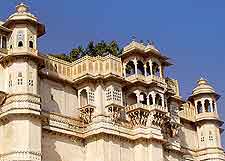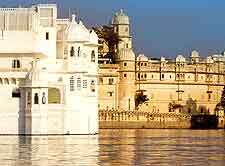Udaipur History Facts and Timeline
(Udaipur, Rajasthan, India)

Famous for its long history and stunning Rajput-era palaces, Udaipur lies in Rajasthan state and was originally the last capital city of the Mewar Kingdom. Surrounded by lakes, it is famous as the Indian 'Venice of the East', with many of the palaces built across entire islands in Lake Pichola and the lakes of Udai Sagar, Swaroop Sagar and Fateh Sagar.
Originally a walled city, Udaipur and its magnificent heritage buildings and winding, narrow streets are overlooked by the fertile foothills of the Aravalli mountain range, giving a journey back in time to visitors.
A City is Founded
Established by Maharana Udai Singh II in 1559 on the legendary advice of a holy man, the city was the last capital built by the ruling dynasty of the Mewar Kingdom, with its first stones laid in 1568, after the Mughal emperor's armies had razed the dynasty's former fort and palace at Chittor.
Unimpressed by the dominance of the Mughal Dynasty, the Maharana's forces regained their independence over the years, recapturing most of the former Mewar holdings with the exception of Chittor, assisted by the remote, mountainous location of the new city. Interestingly, Udaipur's Sisodia Dynasty, still in existence, is the longest unbroken line of rulers in the world and now in its 76th generation.
The 19th Century
With the British Raj in power and the Mughal influence a distant memory, Udaipur became a Rajasthani princely state in 1818, with its capital of the same name continuing as its administrative centre. By this time in Udaipur history, the palace had become one of the largest royal complexes in India, with architectural excellence its hallmark.

New Development and Independence
Ruled by the 73rd Rana of the dynasty between 1884 and 1930, the city of Udaipur saw major development at this time, with the railway, a college, schools, hospitals and dispensaries all established. With the arrival of India's independence in 1947, the 74th Rana, Bhopal Singh (1930 to 1955), was one of the first rulers of India's 500 princely states to pledge loyalty to the Indian Union, agreeing a merger with the other 22 Rajasthan princely states in 1949 and becoming the leader of the newly formed Union of Greater Rajasthan.
Modern-day Udaipur
With the royal institution, titles and financial support abolished by order of the Indian government by 1971, the city's former ruler sold off a selection of his vast estates, establishing a charitable trust to preserve Udaipur's precious history and heritage.
In present times, the foundation is run by Arvind Singh, the 76th generation of the dynasty, and still protects the glory of the city and the magnificent monuments of its proud past.
 Famous for its long history and stunning Rajput-era palaces, Udaipur lies in Rajasthan state and was originally the last capital city of the Mewar Kingdom. Surrounded by lakes, it is famous as the Indian 'Venice of the East', with many of the palaces built across entire islands in Lake Pichola and the lakes of Udai Sagar, Swaroop Sagar and Fateh Sagar.
Famous for its long history and stunning Rajput-era palaces, Udaipur lies in Rajasthan state and was originally the last capital city of the Mewar Kingdom. Surrounded by lakes, it is famous as the Indian 'Venice of the East', with many of the palaces built across entire islands in Lake Pichola and the lakes of Udai Sagar, Swaroop Sagar and Fateh Sagar.